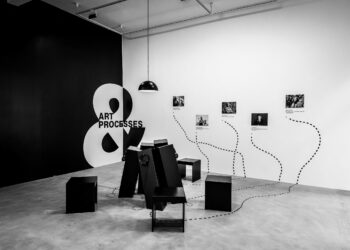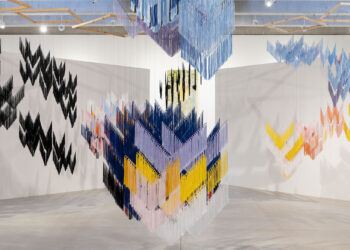‘Human.Nature’
ART AFRICA spoke to Natalie Field about her latest exhibition ‘Human.Nature’ set to be exhibited at Berman Contemporary in April. This series of work explores the cyclic nature of life and death and the interconnectedness of the universe as a monistic whole, bringing to life mythical Finnish folklore and 19th century photographic printing techniques.
ART AFRICA: ‘Human.Nature’ was first conceived during your artist residency at Arteles Creative Centre in Finland in 2016. It was in these Finnish forests that you explored and rediscovered the relationship between human and nature, and the interconnectedness and cyclic nature of life and energy. What was it about this space, about Finland, that inspired this creative journey?
Natalie Field: Every so often life throws us a curve-ball, an event that leads us to question everything we thought we knew. In 2016 I had such an experience and became all too aware of the fleeting nature of our human existence. I needed time to process this experience, and Arteles provided me with the perfect opportunity to step out of the city noise and into a calm and peaceful space ideal for reflection and creation.
The story of our universe begins with a singularity. Due to some inconceivable force, space expanded, and matter formed. The stars, the earth, oceans, animals and even our bodies, are all made from this matter that has existed since the beginning of time. The Merriam-Webster dictionary has a term for this collective: NATURE.
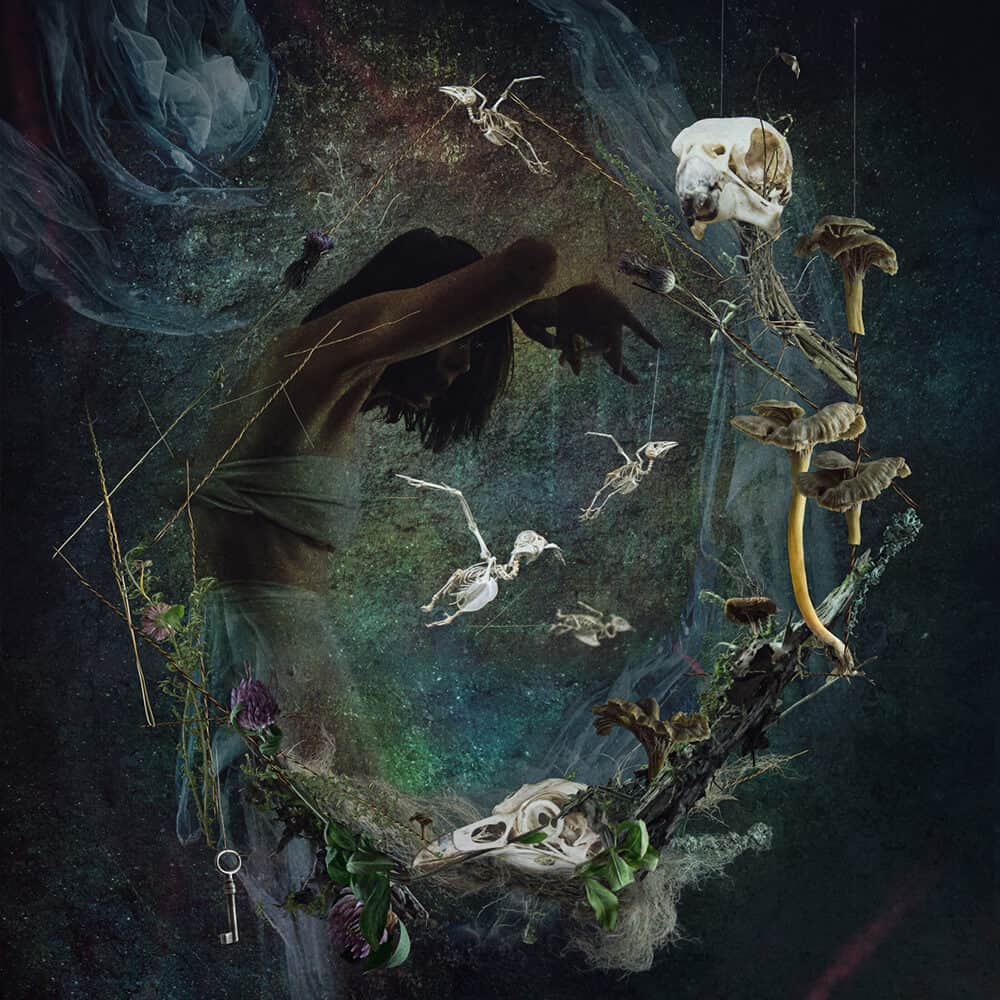 Natalie Field, Birds Nesting in My Head, 2018. Photomontage, Hahnemuhle German Etching, 900 x 900 mm. All images courtesy of the artist.
Natalie Field, Birds Nesting in My Head, 2018. Photomontage, Hahnemuhle German Etching, 900 x 900 mm. All images courtesy of the artist.
Through my work I contemplate the cosmos as a cyclical, closed system that demands balance. Reflecting the principle of the Tao Taijitu: the yin and yang illustrating the interconnectedness of contradictory, yet complimentary dualistic forces that together create a monistic whole.
This mercurial and ephemeral nature of Nature is explored through concepts around creation, evolution, metamorphosis and the transmigration of the soul. Working in a foreign environment, I felt that it was important to draw inspiration from both the Finnish landscape and culture to express these ideas.
In the past, I have connected with nature through hiking and other outdoor activities. Always moving through the space, rather than lingering in it. The remote location of the residency allowed me to visually explore the forest environment in detail, working directly in the landscape to create the cinematic tableaux, as well as collect botanical samples to incorporate into the photomontages I would develop over the next year.
To connect this physical world with the metaphysical, I looked, amongst other things, to Finnish mythologies surrounding concepts of the soul and the transmigration thereof. For this I drew inspiration from two texts. The first is a volume entitled Mythologies of All Races: Finno-Ugric, Siberia by Uno Holmberg, which I discovered during my visit to the National Library in Helsinki. The second, the Kalevala, a 19th-century work of epic poetry compiled by Elias Lönnrot from Karelian and Finnish oral folklore and mythology.
Several images from the cinematic series are imbued with narratives drawn from these texts. For example, a prominent symbol from Finnish culture included in the narratives, is that of a bird. I focussed on the Jackdaw, not only because I enjoy working with “found objects” from the environment, but also because it is a member of the crow family. Throughout folklore, the crow has become known as not only a messenger of death, but also a mediator between the spirit world and ours. According to Holmberg, a bird would deliver a human’s soul to them at birth and collect it again at the moment of their death. This “soul-bird” was known as Sielulintu.
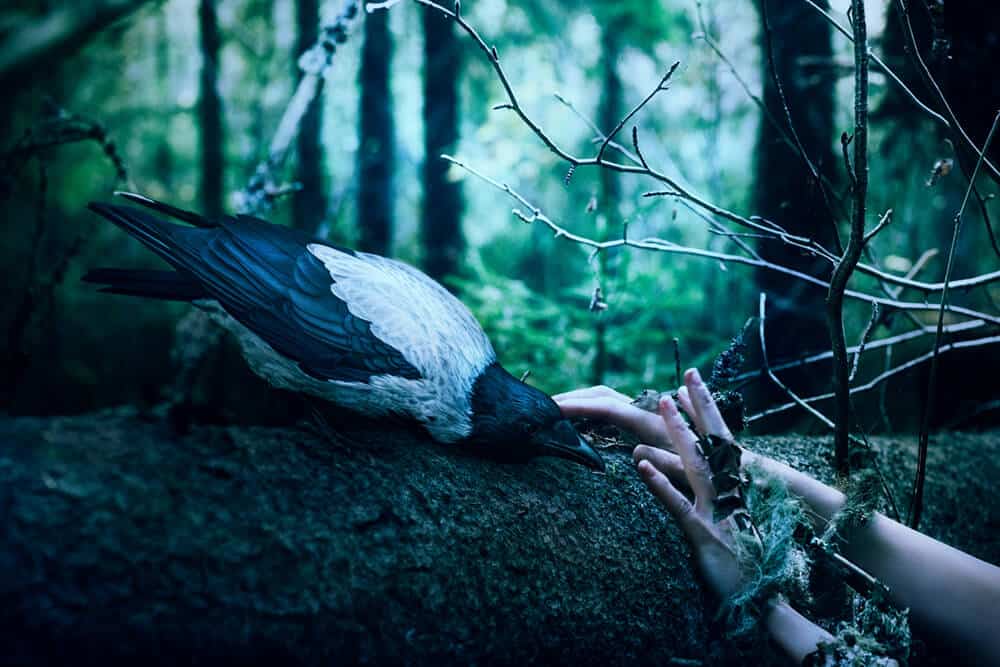 Natalie Field, Sielulintu, 2017. Photography, Hahnemuhle German Etching, 801 x 534 mm.
Natalie Field, Sielulintu, 2017. Photography, Hahnemuhle German Etching, 801 x 534 mm.
The interconnectedness of nature is further explored in a series of photomontages crafted digitally from deconstructed imagery to create suspended still life, in which biological forms are woven together to illustrate the reciprocal interaction found throughout nature. Fuelled by an interest in anatomy, zoology, entomology and botany, these large-format artworks explore the tentative relationship between humanity and its environment. More than celebrate nature, they highlight the interdependence of biotic life forms and their micro-habitats; and the importance of the conservation of this ecosystem that we call home – earth.
You wrote in your artist statement for ‘Human.Nature’ that it was important for you to act as the protagonist in this personal narrative and exploration of life and death. What was it like performing in front of the camera and adding performance art onto an already impressive repertoire?
Going solo on my excursions into the forest allowed me to fully experience both nature and photography, uninterrupted, in a way that I have never done before. Although the human form has always been present in my work, past series have been collaborations with models, dancers and yogis. But this one was a personal journey, not only the physical experience, but also with regards to the subject matter.
I found something there that I had not expected. Lying down in the soft moss of the forest was peaceful. Dancing in the forest with the literally freezing air stroking my warm skin made me feel alive.
Working on my own required of me to develop a new process. Once I established the scene for an image, I would set the camera up on a tripod, and then use the intervalometer to automatically capture images at pre-defined intervals. During these exposures, I would let go, tapping into my subconscious to interpret the moment through movement and dance. Fellow artist Kathy Moss calls this the ‘reverie state’. I believe it to a be a form of automatism: the narrative acted out in front of the camera without truly knowing what is being captured in the frames.
This new process further contributed to the evolution of my technique, when I stumbled upon an alternative direction for my long exposure work: stop-motion movies. During the creation of the still image, Dancer in the Woods, I was scrolling through the frames on the back of the camera when I noticed how interesting it looked to play through them quickly. It reminded me of vintage animated art frames. I consequently adjusted my performance to move into the frame from one side and out the other. I then stitched them together to create a short video piece depicting a figure strobing across the frame, looped for a Groundhog Day effect. The latter will also be on display as part of a larger video installation at the exhibition.
When viewing this collection of work, the cyanotype photographic prints are quite a contrast to the mythical and surrealist digital images. Could you explain the role these images play in the wider collection and what it was like experimenting with this traditional practice of essentially creating ‘blueprints’?
A big part of my creative process relies on the digital capture of natural elements, which are deconstructed in post-production, to be reconstructed into new realities. However, I also wanted to celebrate the innate beauty of the botanicals themselves. My first expression of this was to create direct copies using a digital scanner with accompanying annotations as one would see in traditional herbarium collections.
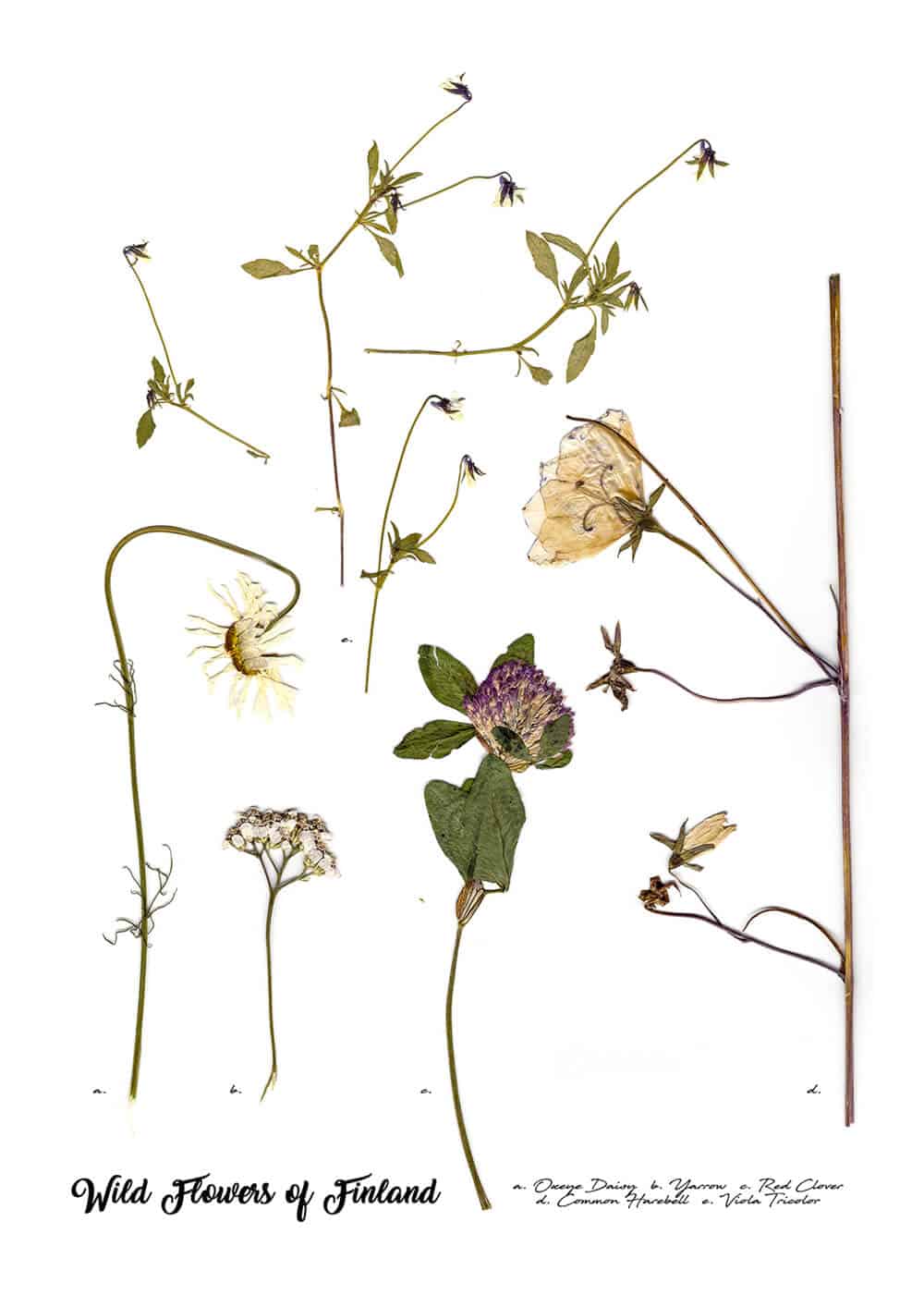 Wild Flowers of Finland
Wild Flowers of Finland
Upon discovering the work of Anna Atkins, I fell in love with the idea of returning to my photographic roots and using the cyanotype technique. For those not familiar with her work, Atkins made history when she compiled her photograms of dried algae into the first book ever to be published with photographic illustrations: Photographs of British Algae: Cyanotype Impressions (1843). I was curious to see how I could implement this traditional process to capture an alternative view of my own samples, and attended a workshop with the Alternative Print Workshop to learn this new skill in 2017.
Rather than capture all the details like the scanner, the cyanotype offers a more eerie representation of the subject matter. The resulting images are reminiscent of the nuclear shadows seen in Hiroshima, in which only the outline of the object remained. This ‘impression’ of reality resonates with the ‘Human.Nature’ theme of the ephemeral. In time the botanical samples themselves will fade and decay, and only the Sol-Shadows, the sun-imprinted memories, will remain as evidence that they ever existed.
What started out as “blueprints” quickly evolved into an artistic expression of this theme. By applying the chemicals onto the paper in splashes and runs, the solid shapes of the hexagons start bleeding and fading much like the subject matter itself. Adding household items, like sugar in the exposing stage and fabric cleaner in the washing stage, enables me to express the concept further through the markings on the paper.
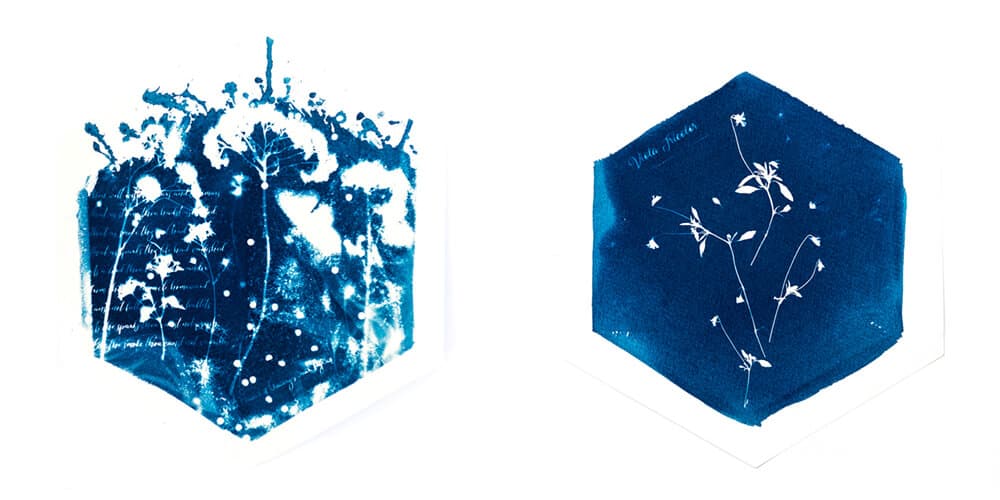 LEFT: Natalie Field, Sol-Shadows #33, 2018. Cyanotype on Fabriano, 365 x 300mm. RIGHT: Sol-Shadows #21, 2018. Cyanotype on Fabriano, 265 x 225 mm.
LEFT: Natalie Field, Sol-Shadows #33, 2018. Cyanotype on Fabriano, 365 x 300mm. RIGHT: Sol-Shadows #21, 2018. Cyanotype on Fabriano, 265 x 225 mm.
Your latest interest is said to lie with the experimentation of in-camera effects. What is it about this specific visual manipulation as opposed to post-production that captivated your interest? Could you expand on how you implemented this process, in which pieces, in ‘Human.Nature’?
I first became piqued by the idea of using in-camera techniques, like motion blur and multiple exposures, while working on the series ‘Breathe in… Breathe out… Let the human in…’ (2015). I was creating a collage of several layered images in post-production, when it dawned on me to create similar effects through the medium itself. After much research and several test shoots, I created the series ‘Animal Within’ (2015). The latter explored the concepts of animalism and therianthropy (shape-shifting), through a dancer’s performance. The unpredictable results of these experiments were reminiscent of my first experiences working in a darkroom: watching with a sense of wonder as the images developed on paper in the chemical bath. I was capturing images beyond my own imagination, and a new passion was born.
It was my interest in this spontaneity that first led me to automatism, the technique developed during the Surrealist movement, which shifts the act of creating from conscious control to chance.
By virtue of their nature, in-camera techniques encourage the photographer to relinquish control and enter the world of the unexpected image. In this manner, the works and process itself are allowed to take on a life of their own.
These techniques have proven to be very useful in expressing my themes around the mercurial and ephemeral, as they allow me to physically capture transient energy through movement. For this series I used slow-sync flash to illustrate the spirit in the Ört-Bi and Stone Circle images. Working with long exposures, I would throw and swirl fabric around to capture movement, whilst simultaneously lighting parts of the scene with bursts of flash to capture stillness. I also applied a mix of multiple and long exposure photography to capture the translucence of the human form in Fading.
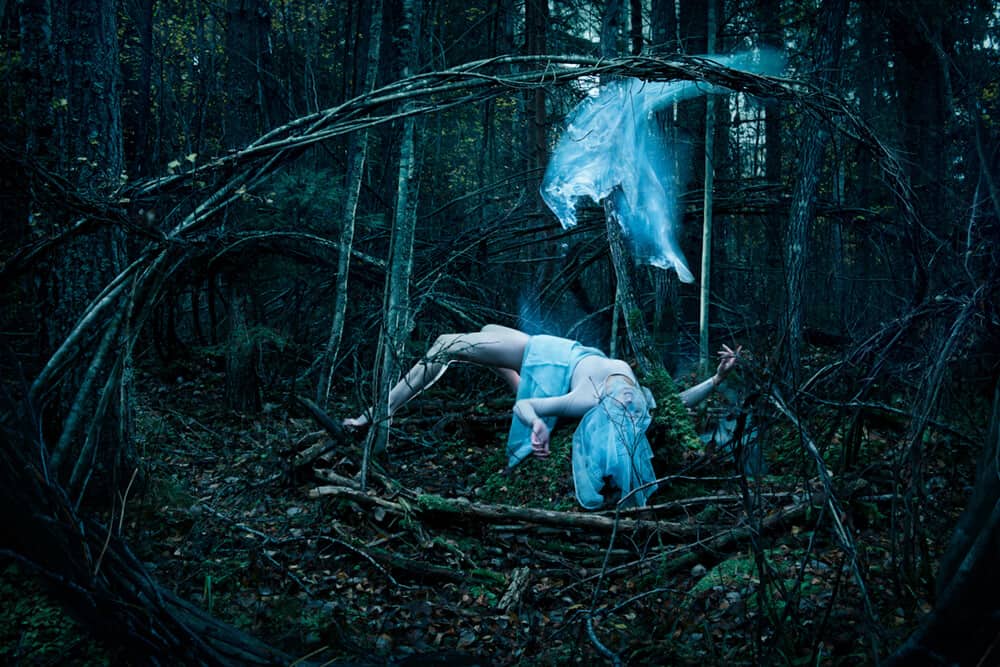 Natalie Field, Ört-Bi, 2016. Photography, Hahnemuhle German Etching, 801 x 534 mm.
Natalie Field, Ört-Bi, 2016. Photography, Hahnemuhle German Etching, 801 x 534 mm.
In your artist statement for ‘Human.Nature’ you wrote that this work was a reaction to your fear of dying. What is it about death that you are so fearful of? Did you manage to find the solace you were after in the process of creating this collection?
I suppose it is in our human nature to fear the loss of our individual identity. From pharaohs determined to travel to the afterlife with all that they possessed, to leaving a legacy through one’s children, people continue to look for ways to burn the memory of themselves into this world. For me, it would be through my art. For I felt, then, an urgency to create, to confront the idea of self.
My research during the residency led me to the conclusion that creation (the physical world, including our bodies) and consciousness (the immaterial force of life) are but a single energy simply vibrating at different frequencies. And as per Einstein’s first law of thermodynamics, energy cannot be created nor destroyed, it can only be changed from one form to another. The images presented in ‘Human.Nature’ celebrate this infinite cycle of life, and the interconnectedness of all matter and energy. For in time, this energy that was once you, will transmute to form new life.
To me, this continuation of the life-force is the transmigration of the soul.
BUT, through this process, your conscious mind, your identity, this person with these thoughts and memories, will be lost forever. This is your one chance to be a combination of this mind, in this body, at this time, in this space. This very moment is a unique human experience. It is truly a gift. And the real question is: What will you do with this one life?
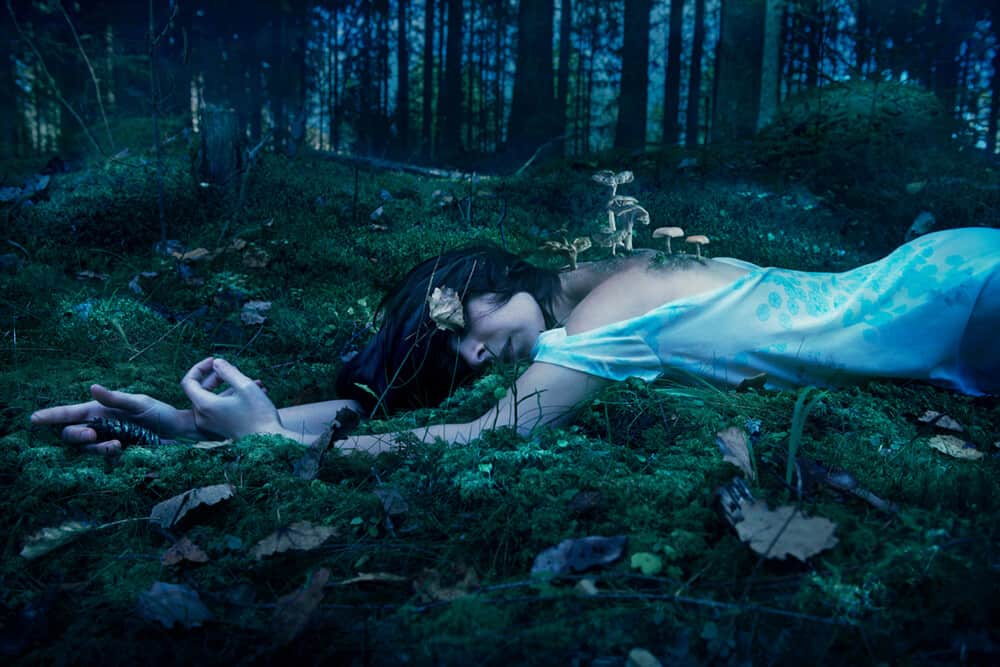 Natalie Field, To Give Life Anew, 2016. Photography, Hahnemuhle German Etching, 801 x 534mm.
Natalie Field, To Give Life Anew, 2016. Photography, Hahnemuhle German Etching, 801 x 534mm.
